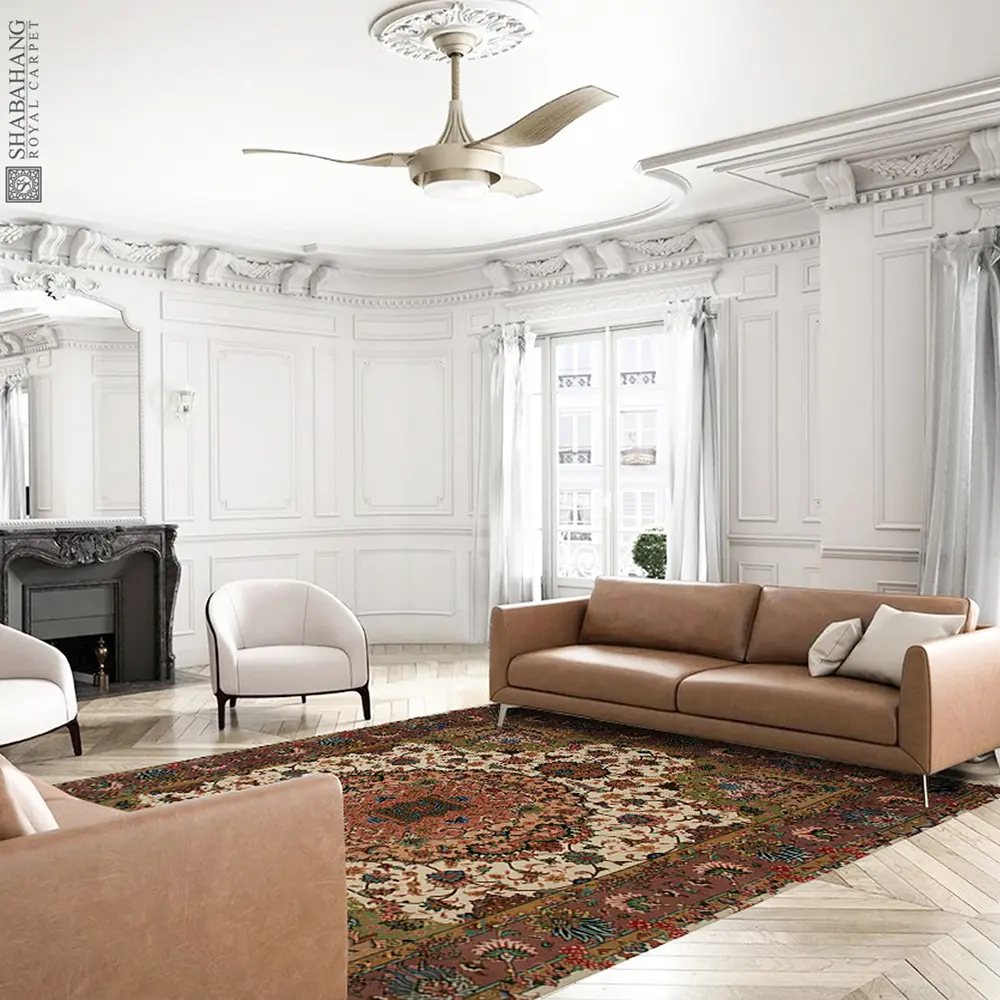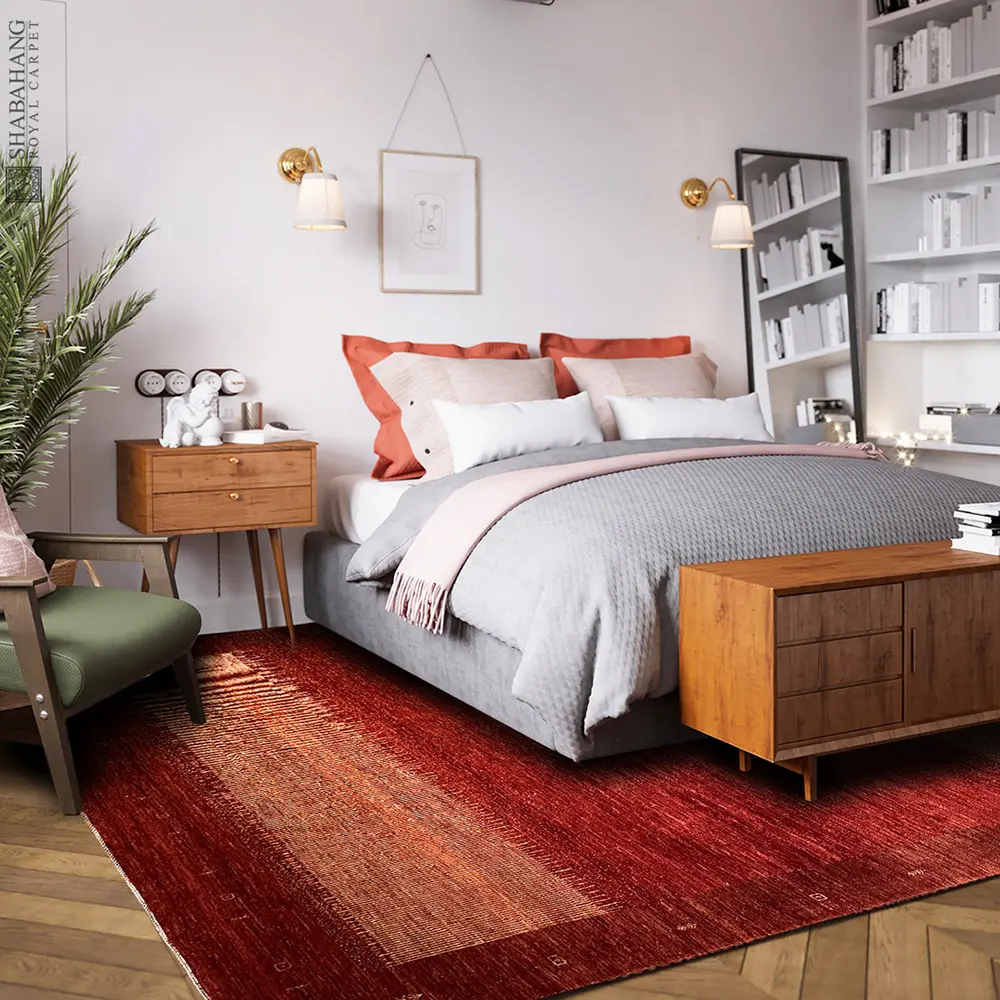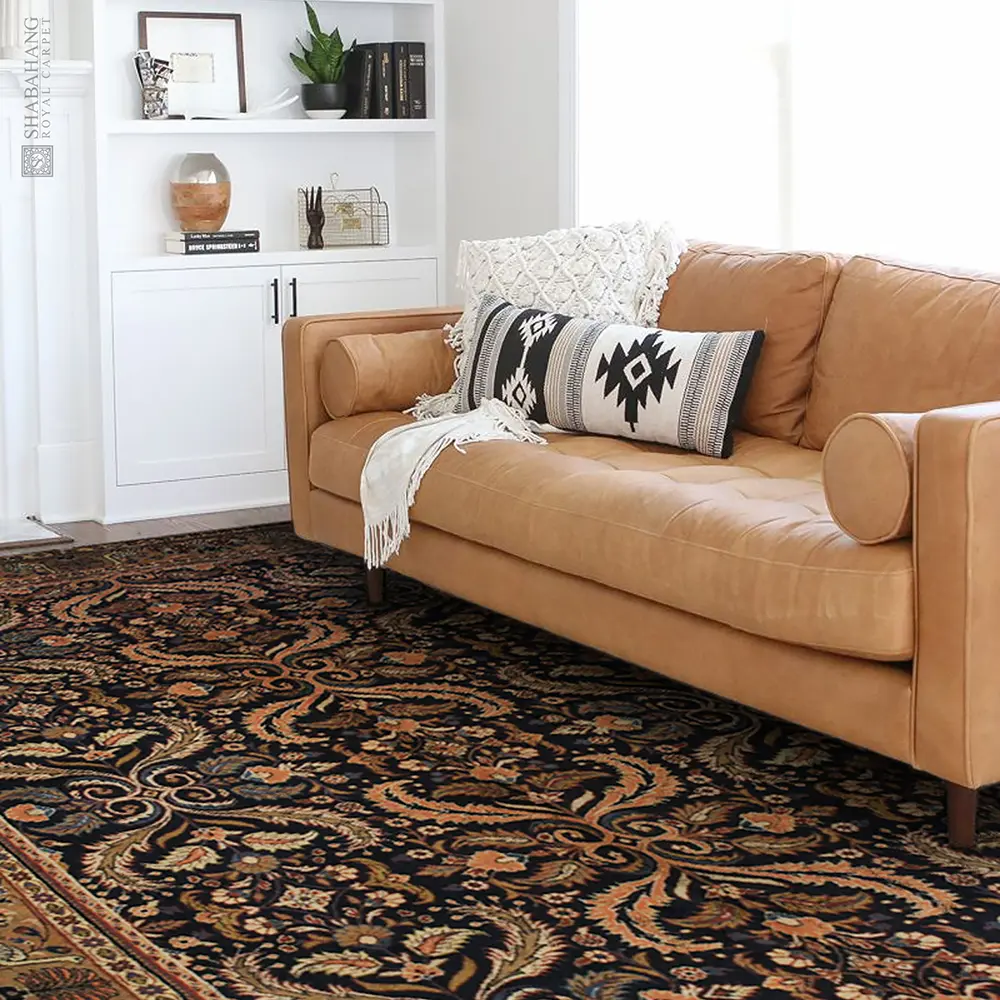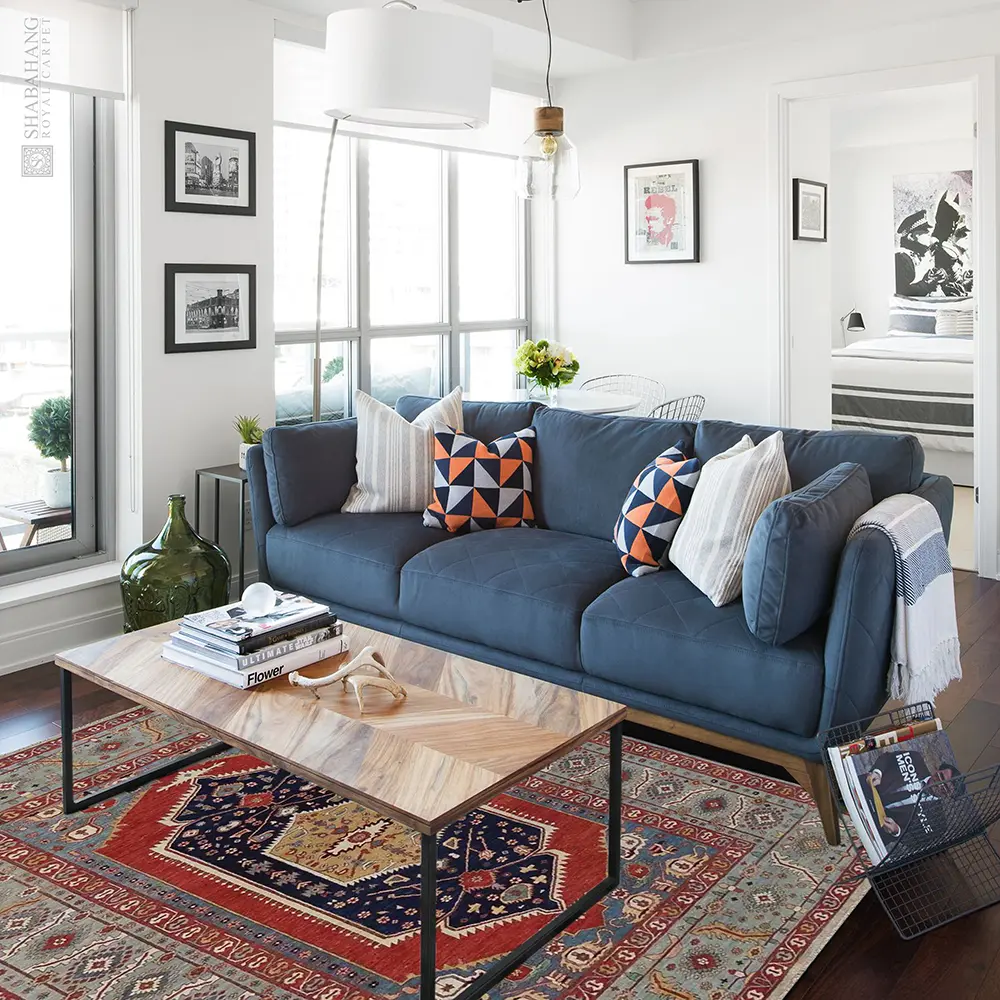An area rug might be the ideal design choice if you enjoy the plushness of carpets but dislike the “wall-to-wall” appearance. In this article, we go through what area rugs are, why they are helpful, and some tips for using them to decorate hardwood floors.
What’s an Area Rug?
A rug that does not reach the walls is called an area rug. It primarily serves to secure furniture in place.
A rug that merely covers a part of the floor is called an area rug. It provides several advantages, unifies a space, and adds character and warmth.
A rug is a thick, heavy cloth used as a floor covering that typically has a nap or pile. An area rug, which you can even place on top of carpeting, is a rug that covers a portion of the floor instead of wall-to-wall carpeting. Area rugs can also be moved from one room to another because they are lightweight and transportable.
Area rugs are available in various sizes; some of the most popular sizes are 5’x7′ and 8’x10′. While some area rugs have irregular, organic shapes, others are geometric (often rectangular or circular in design) (such as sheepskin or cowhide area rugs).
Area Rugs: Why Use Them in Interior Design?
There are several reasons to use an area rug in interior design, but the most obvious one is aesthetic. This may help to explain why area rugs are so common.
An area rug indeed provides a room with a trendy appearance and quickly transforms it. Additionally, it has a distinctive way of bringing all ornamental aspects together. However, the advantages of area rugs go far beyond fashion.
Benefits of Using Area Rugs
There are numerous benefits to having an area rug in a living room, bedroom, or another area where people congregate. Area rugs offer coziness, warmth, and aesthetic appeal (color, pattern, texture, etc.). Additionally, they can serve as a framework for placing furniture and defining spaces.
They are incredibly adaptable, separate different areas of your home, and serve as a decorative accent. They aren’t the only way to designate a space or set boundaries.
Here are some of the many benefits of adding a rug to your house, including how useful they will be for furnishing.
It infuses warmth:
Area rugs are required in homes without heated floors. Area rugs retain heat because of their higher insulating value. Additionally, area rugs add a tactile and visual layer that softens hard surface flooring. In turn, this makes any space cozier.
An area rug unifies the space.
Would you like to enclose a room in your house? They are adding a room’s area rug. Area rugs give a room a connected, coherent aspect even when the furniture appears to float in the space.
However, area rugs have the perfect amount of transforming power. More significant is always better! For instance, a living room’s area rug must be large enough to accommodate all the furniture. If it is too tiny, place the carpet in the middle of your coffee table.
Area rugs absorb sound!
Area rugs offer a sound-dampening effect that significantly reduces noise in your room. Carpets or area rugs, which also absorb sound from the air, absorb the vibrations created when people walk on hard floors, which account for most noise in homes. For the neighbors below, the area rugs are excellent. However, having a calmer environment also makes it simpler for you to unwind, recharge, study, read, and sleep.
Rugs are artistic creations.
Rugs are works of art when used as decorative elements. They can be a natural canvas for any combination of hues, textures, and patterns. A visually appealing rug aids in establishing a chic and dynamic space. Some area rugs, such as those in the handwoven style, can also be hung on a big wall.
A good rug is durable.
A high-quality area rug can last many years if properly cared for. Try using high-quality area rugs that you can also find in Shabahang Royal Carpet.
When To Purchase Area Rugs?
Purchasing area rugs when nobody thinks about staying warm and comfy is a simple rule of thumb. This indicates that the best months to buy rugs and carpets are June, July, and August.
Area Rug Guidelines to Follow
Due to their ease of removal and cleaning, area rugs are an excellent substitute for wall-to-wall carpeting. They also require less commitment, and if you get bored or decide to redecorate, it’s simple to swap one out.
There are crucial guidelines to remember while using area rugs in your home. Check out these area rug decorating dos and don’ts before you buy.
- Keep Rugs Extended Under Furniture: Ensure the area rug you choose reaches beneath all the critical pieces of furniture in the space. For instance, in a living room, you should place all the furniture on top of the rug. Having the front legs of large upholstered pieces on the rug and the back legs off is acceptable if this is not practicable. Smaller pieces’ legs should all be on the carpeting, however. The rug in a dining room should be big enough to cover both the table and the chairs. The chairs must be placed on the rug, even when you take them away from the table.
- Cover High-Traffic Areas: Ensure that the rug you select covers places with a lot of foot activity. People shouldn’t walk through with one foot on the area rug and the other off. It’s inconvenient and uncomfortable and might cause the rug and your flooring to show strange wear patterns.
- Don’t make the area rug too small: If an area rug doesn’t go beyond the bed, what good is it? Instead of plush carpeting, you’ll walk out of bed onto a chilly, unyielding surface. Before you go shopping, make sure you take accurate measurements. For a twin or double bed, the rug should ideally reach beyond the sides by at least 12 inches and at least 18 inches for a queen or king bed. Although you can go higher, these figures should be the absolute minimums you seek.
- Never sacrifice size: The most prominent error people make when using area rugs as décor is choosing ones that are too small. This makes sense, especially considering the cost of some of the oversized rugs. Going big now will prevent you from replacing a failing one later. In addition, a rug still costs less than a room’s worth of carpet.
- Embrace color and pattern without fear: Shoppers should embrace color and pattern to add joy and playfulness to the environment with area rugs. If, after a few years, you decide you don’t like it, you have lots of affordable options to choose from.
- Avoid putting your top-quality rugs in danger: While it may be tempting to put your nicest carpeting in a room that serves as the focal point of the house, such as your dining room, you should reconsider. It’s advisable to avoid putting expensive area rugs in places where spills and accidents are likely to occur. Despite being cleaner than broadloom carpet, rugs can still be challenging to stain-remove. Remember this, especially if you have kids or pets. In the riskier sections of your home, it might be preferable to choose inexpensive, simple-to-clean alternatives because you can’t always control what your family does on the rug.
- Use a different rug in each zone of a particularly large room if you have one. The rugs don’t have to match. However, they ought to be connected by color or pattern.
- Large spills may result in lasting damage to rugs made of natural fibers, such as jute and sisal, because they are typically not washable. Nevertheless, they don’t exhibit light stains and dirt as readily as other fibers.
Cheap vs. High-Quality Area Rugs
A cheap rug would be anything affordable due to the low-quality components and manufacturing processes used to create it. You want a reasonably priced rug of decent quality, not cheap.
When purchasing in-store, take your time to study all of the fine print, tags, and extensive descriptions. Here are a few factors that could make a rug more affordable than others.
- Irregularities: Rugs with uneven sides made hastily are regarded as irregular. If the dimensions of your 5′ x 7′ rug are 4′ 9.5″ on one side and 4′ 11″ on the other. It is erratic, and the pricing ought to reflect that.
- Synthetic Fibers: Cheaper rugs made of synthetic fibers tend to last less than natural fibers (like wool). They are significantly less expensive to produce, which accounts for their lower price, but if you want something that will last for a long time, choose a rug made of natural fibers.
- Machine-Made vs. Hand-Made: It should go without saying that handcrafted rugs will cost significantly more than their machine-made equivalents. This only sometimes implies that a machine-made rug will be of good quality, but if you’re seeking something to become a family treasure, choose something done by hand to assure excellent quality.
Conclusion
Finally, area rugs are essential if you have a specific flooring or floor plan. If you know where to search, you can find them for a reasonable price, and the proper placement of your area rug may transform your space from plain to lovely.
Although hardwood floors may not require area rugs, there are several functional and aesthetically pleasing benefits. Consider the benefits we covered in the last section if you need clarification.
If you are looking for a high-quality area rug, visit Shabahang Royal Carpet. You will be surprised by the variety, models and impressive quality of carpets!




